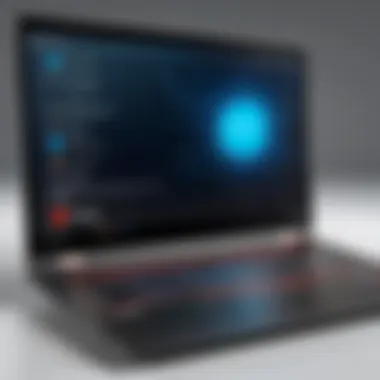Fix Lenovo Laptop Wireless Network Issues in Windows 10


Intro
Wireless connectivity has become a cornerstone of our digital lives. Lenovo laptops are popular among users who seek reliable performance and attractive design. However, encountering issues with wireless network detection in Windows 10 can be frustrating and disruptive. Not only does it hinder connectivity, but it also impacts overall productivity. In this article, we delve into the technical and practical aspects of troubleshooting these wireless connection problems. We aim to equip users, from tech enthusiasts to everyday users, with effective strategies to restore their device's connectivity.
Overview of the Technology
Understanding the technology behind wireless networks in Lenovo laptops is crucial for troubleshooting. Many models are equipped with advanced wireless cards that support modern Wi-Fi standards such as IEEE 802.11ac or 802.11ax. These standards enable faster data transfer and better range, ensuring a stable internet experience.
- Key specifications: Lenovo laptops typically use Realtek or Intel wireless adapters. The specific specifications may vary among different models but often include dual-band support, allowing connections on both the 2.4 GHz and 5 GHz bands.
- Unique selling points: One prominent selling point is the user-friendly interface of Windows 10 that allows seamless management of network settings. Additionally, it's essential that users maintain up-to-date drivers to support all features of the wireless cards and ensure maximum performance.
Design and Build Quality
The build quality of Lenovo laptops reflects a focus on durability and usability. Many models feature a lightweight chassis made from plastic or metal, depending on the range. User comfort is considered in their design. Function keys for wireless control allow for easy toggling between states.
- Material used: The use of high-quality materials contributes to both the aesthetics and sturdiness of the laptops. Models in the ThinkPad series often incorporate carbon-fiber elements, making them robust yet lightweight.
- Ergonomics and usability: Lenovo laptops emphasize ergonomic keyboard layouts and touchpads, enhancing user experience. The placement of wireless switches simplifies the process of troubleshooting connectivity issues, positioning it as an important factor in connectivity dilemmas.
In the following sections, we will explore various causes of wireless detection failure, delve into potential hardware and software issues, and provide actionable solutions for each scenario. By the end, readers should have a solid understanding of both the technology and practical steps needed to resolve any wireless connectivity challenges they may experience.
Preface to Wireless Network Detection Issues
Wireless network detection issues can significantly hinder the functionality of any device, especially a Lenovo laptop running Windows 10. Understanding this topic is essential as it allows users to effectively address connectivity challenges that may arise in various contexts, from remote work to streaming entertainment.
When a Lenovo laptop cannot detect available wireless networks, it can feel frustrating. This problem may stem from a variety of factors, including hardware malfunctions, outdated software, or incorrect settings. The importance of recognizing these issues early cannot be overstated. Prompt awareness leads to quicker resolutions, minimizing disruptions in workflow or leisure. Knowing the signs of wireless network detection failures is the first step in troubleshooting and restoring connectivity.
The benefits of understanding wireless network detection issues extend beyond just fixing a problem. This knowledge empowers users with the skills needed to optimize their devices for better performance in the long run. Furthermore, it ensures a proactive approach when dealing with technology, which is particularly relevant for tech-savvy individuals who often rely on reliable internet connections.
Considerations around this topic include the integration of diagnostic tools, such as Windows Network Troubleshooter, and the role of device drivers in maintaining connectivity. These aspects will be explored in depth in subsequent sections.
In essence, this article aims to equip users with the necessary tools and understanding to troubleshoot Lenovo laptop wireless network detection issues effectively. Through detailed analysis and practical solutions, we aspire to enhance users’ experiences with their devices while expanding their technical competencies in wireless networking.
Understanding Wireless Networks
Wireless networks are the backbone of modern connectivity. Understanding how they function is essential when addressing detection issues, particularly for Lenovo laptops running Windows 10. This section expands on the concept of wireless networks, highlighting their significance in facilitating seamless communication between devices.
With the rise of remote work and digital collaboration, the reliance on wireless networks has surged. Knowing the basic principles and components of a wireless network empowers users to troubleshoot problems effectively. When a Lenovo laptop fails to detect available networks, it may lead to frustration and a decline in productivity. By grasping the underlying technology, users can approach troubleshooting with a clearer perspective.
Basic Principles of Wireless Connectivity
Wireless connectivity operates through radio waves, allowing devices to communicate without direct physical connections. At its core, a wireless network comprises two main elements: a transmitter and a receiver. The transmitter, typically in the form of a router, sends data signals through the air. The receiver, such as your Lenovo laptop, picks up these signals using its wireless adapter.
Several protocols govern wireless communications, with the most common being Wi-Fi. Wi-Fi technology utilizes frequency bands, typically 2.4 GHz and 5 GHz. Each frequency band has unique characteristics affecting range and speed. Users must understand these principles to assess why their Lenovo laptop may not detect available networks.
The quality of the signal is influenced by various factors, including distance from the router, obstacles like walls, and interferences from other devices.
Components of a Wireless Network
A wireless network consists of several key components, each playing a distinct role in ensuring connectivity. Understanding these components helps diagnose issues effectively.
- Router: The central hub that distributes internet access to various devices. It's essential for managing network traffic.
- Wireless Adapter: This component in your Lenovo laptop enables it to connect to the wireless network. If faulty, it may hinder network detection.
- Modem: Often combined with routers, modems connect your network to the broader internet.
- Access Points: These extend the wireless coverage beyond what the router can provide, especially in larger spaces.
"Understanding the components of a wireless network is crucial for effective troubleshooting."
Familiarity with these elements not only aids in understanding network detection issues but also enhances overall user experience. The more informed a user is about wireless networks, the better equipped they are to diagnose and resolve connectivity problems.
Identifying the Problem
Identifying the problem is a crucial initial step in resolving wireless network detection issues on Lenovo laptops using Windows 10. Understanding the specific malfunction can save time and lead to more effective solutions. Without accurate identification of the problem, one might implement incorrect fixes, which can prolong connectivity issues or introduce further complications. This section highlights the necessity of determining the source of the issue, as it guides users toward appropriate troubleshooting steps.


Symptoms of Wireless Network Detection Failure
Recognizing the symptoms of wireless network detection failure can point toward the underlying issue. Common signs include:
- Unable to find networks: The laptop fails to display any wireless networks in the available connections list.
- Limited connectivity: The laptop connects to the network but does not access the internet.
- Frequent disconnections: The device disconnects from the network sporadically, indicating instability.
Each of these symptoms may suggest different causes, ranging from software conflicts to hardware issues. A careful observation of these aspects enables users to narrow down the potential causes of their connectivity dilemmas. Moreover, recognizing these symptoms promptly could help in contacting support services with precise information, enhancing the problem resolution process immensely.
Common Questions to Consider
When faced with wireless network issues, there are several common questions that one should consider to better understand the situation and identify the problem:
- Is the Wi-Fi enabled on the laptop?: Check if the wireless function is turned on, as this is a common but overlooked aspect.
- Are other devices connecting properly?: If other devices can connect to the same network without issue, the problem might be specific to the laptop.
- Have recent changes been made during updates?: Software updates can inadvertently disrupt connectivity. A review of recent updates might unveil the culprit.
- Is the signaling strength stable?: Weak signals may not appear in the detected networks but could cause intermittent connection issues.
Addressing these questions will guide users in pinpointing the root cause of the issue better. Recognizing patterns among the symptoms and queries fosters a methodical approach to troubleshooting. Moreover, these initial assessments can often lead to straightforward solutions, easing the overall process and potentially avoiding deeper investigations into hardware malfunctions.
Initial Troubleshooting Steps
When dealing with wireless network detection issues on Lenovo laptops running Windows 10, initial troubleshooting steps serve as a crucial first line of defense. These steps can often resolve many problems without the need for significant technical intervention. Understanding the importance of these preliminary actions contributes significantly to problem resolution. Often, users may overlook simple solutions, focusing instead on complex diagnostics that may not be necessary. By starting with straightforward checks and adjustments, users can save time and resources.
Rebooting Your Device
One of the simplest yet most effective methods for resolving connection issues is rebooting your device. This action clears out temporary files and resets active processes, which may be the root of the problem. Simply powering off your Lenovo laptop, waiting a few moments, and then turning it back on can resolve a range of minor connectivity issues. Many users report immediate improvements in their network detection simply by rebooting. Therefore, it is always recommended to try this step before delving into more complex troubleshooting.
Checking Physical Wi-Fi Switch
Countless Lenovo laptops have a physical Wi-Fi switch, which can be easily overlooked. This switch may be located on either side of the laptop or above the keyboard, depending on the model. Ensure that it is in the ‘on’ position. If the switch is inadvertently turned off, your laptop will not detect any wireless networks. This is an essential check that can prevent unnecessary troubleshooting processes. Pay close attention to this step as it is simple, yet a common cause of connectivity issues.
Network Connection Status
Monitoring the network connection status can also provide valuable insight into the issue. To assess your connection, navigate to the Network & Internet settings from the taskbar icon. Click on 'Network Status' to see if your device indicates that it is connected to a network. Additionally, look for any error messages that may hint at the problem. The status may show you whether the wireless capabilities are functioning properly or if the device is limited in its connectivity. Being proactive in checking the network status can help identify where the issue lies, whether it is with the laptop, the router, or elsewhere.
"The simplest solutions are often the most effective. Don't overlook basic troubleshooting techniques."
In summary, engaging in these initial troubleshooting steps can lead to significant advancements in resolving wireless network detection issues. They encourage a systematic approach where users can quickly dispatch minor hiccups before escalating to more involved fixes.
Advanced Troubleshooting Techniques
In any scenario involving wireless network issues, advanced troubleshooting techniques can be crucial for restoring connectivity. When initial steps do not yield results, diving deeper into network configurations and device settings often reveals underlying problems that casual users might overlook. By employing methodical and thorough approaches, one can enhance both understanding and functionality of their Lenovo laptop's wireless capabilities.
Updating Wireless Drivers
Wireless drivers are fundamental to ensuring proper communication between your Lenovo laptop and wireless networks. An outdated or corrupted driver can easily lead to connection issues. To update the driver:
- Access Device Manager: Right-click on the Start button and select Device Manager.
- Locate Network Adapters: Expand the section for Network adapters. Look for your wireless adapter, typically named something like "Realtek 802.11n Wireless LAN Card."
- Update Driver: Right-click the wireless adapter and select Update Driver. Choose "Search automatically for updated driver software."
Updating wireless drivers often resolves compatibility issues with Windows 10 updates or newly released network hardware. If automatic updates do not work, consider downloading the latest drivers directly from Lenovo's support website.
Resetting Network Settings
Resetting network settings can be one of the most effective methods to rectify persistent wireless detection problems. This action restores all network-related configurations, including Wi-Fi, VPN, and Ethernet settings, to their original state. To perform this reset in Windows 10:
- Open Settings: Click on the Start menu and then Settings.
- Network & Internet: Select Network & Internet and navigate to the Status tab.
- Network Reset: Scroll down and click on Network reset. Follow prompts to confirm your choice.
Keep in mind that this will remove all saved networks, and you will need to re-enter Wi-Fi passwords afterward. This step is essential when previous configurations conflict with current network settings.
Using Windows Network Troubleshooter


The Windows Network Troubleshooter is a built-in tool designed to diagnose and repair common network problems. It can automatically identify issues and apply fixes. Here’s how to access it:
- Settings: Go to the Start button and click on Settings.
- Network & Internet: From there, select Network & Internet.
- Network Troubleshooter: Click on the Change adapter options. Right-click on the Wi-Fi icon and choose the option to Troubleshoot.
Using the troubleshooter is a straightforward way to assess your network status and implement needed repairs. On many occasions, it can fix issues that manual adjustments might miss.
Checking Hardware Components
When diagnosing wireless network detection issues with Lenovo laptops running Windows 10, evaluating hardware components is crucial. The wireless adapter and network hardware play significant roles in enabling connectivity. If any low-level hardware problems exist, these can directly hinder your device from detecting available networks. Recognizing these components and ensuring they are functioning properly is a proactive step that can save time and frustration during troubleshooting.
Inspecting the Wireless Adapter
The wireless adapter is a critical piece of hardware that connects your laptop to Wi-Fi networks. If this component is malfunctioning, it can lead to the inability to detect networks.
To inspect the wireless adapter, start by checking the Device Manager. You can access it by pressing Windows + X and selecting Device Manager from the list. Look for "Network adapters" and expand the section. Here, you should see the wireless adapter listed. If it shows a yellow exclamation mark or is absent altogether, this signifies a problem. You may need to update or reinstall the drivers.
Remember that physical damage can also affect the wireless adapter. Look for signs of wear, such as bent pins or loose connections. If issues persist after driver updates, consider reseating the adapter, if possible, or replacing it. Regularly checking your wireless adapter is a good practice to prevent connectivity problems down the line.
Validity of Network Hardware
Beyond just the wireless adapter, the overall validity of the network hardware must be assessed. This includes the router and any additional networking devices connected to it. Poor or improper configurations in these devices can impact your Lenovo laptop's ability to connect to Wi-Fi.
To check your network hardware's validity, perform the following actions:
- Examine Connections: Ensure all cables are properly connected, including power cables and Ethernet connections if applicable.
- Check Router Status: Look for indicators on the router. Ensure that the Wi-Fi signal is active and that there are no red lights indicating issues.
- Run Diagnostic Tests: Many routers come with built-in diagnostic tools or interfaces accessible through a browser. This can help identify problems and provide suggestions for fixes.
Regular maintenance and checks on your network hardware can prevent connectivity troubles from arising unexpectedly.
By prioritizing hardware checks, you can identify foundational issues that directly relate to network detection problems. The success of wireless connectivity often rests on the health and functionality of these components.
Configuring Windows Settings
Configuring Windows settings on your Lenovo laptop is crucial for resolving wireless network detection issues. Proper settings ensure that the operating system can identify available networks and manage connections efficiently. This section will delve into specific elements and benefits associated with configuring these settings. Adjusting your Windows settings can lead to more stable connections, improved performance, and an overall better user experience.
Understanding how to access and modify settings can help to alleviate common connection problems. Additionally, it empowers users with the knowledge to prevent future issues. Whether it is adjusting firewall settings, enabling features that assist with network detection, or managing existing connections, these configurations hold significant importance.
Accessing Network and Sharing Center
The Network and Sharing Center is a central hub in Windows where you can manage your network connections. To access it:
- Open the Control Panel from the Start menu.
- Select "Network and Internet".
- Click on "Network and Sharing Center".
This area shows your current network status, allowing you to view information such as active connections and available networks. You can also modify different settings related to your network.
It is important to verify that your wireless adapter is enabled here. If not enabled, your Lenovo laptop will not detect any wireless networks. To enable it, simply click on the adapter settings and select the option to enable it. Furthermore, checking for any alerts is critical. The center often provides warnings if there are issues with the connection or configuration. Taking action on these alerts can significantly enhance your network performance.
Managing Advanced Sharing Settings
In the Advanced Sharing Settings section, you can customize how your laptop interacts with other devices and networks. Here’s how to access it:
- In the Network and Sharing Center, find and select "Change advanced sharing settings" on the left sidebar.
- Here, you will see various options relevant to private, guest or public, and all networks.
Consider enabling options such as "Turn on network discovery" and "Turn on file and printer sharing". This is particularly beneficial if you are in a mixed environment where devices need to communicate seamlessly. Be cautious with the public and private settings as they can affect your device's security and visibility.
Remember to save your changes once you configure these settings. Proper management of these options ensures that your Lenovo laptop not only detects wireless networks but also connects to them without unnecessary interruptions.
Regular checks on your Network and Sharing Center and Advanced Sharing Settings can prevent many common wireless issues.


Verifying Router Settings
In the process of troubleshooting wireless network detection issues on Lenovo laptops, verifying router settings plays a crucial role. Often, problems stem not only from the laptop but also from the router itself. Ensuring that the router settings are correctly configured can lead to improvements in network detection and connectivity. This section provides insights into various aspects of router settings that can impact wireless performance.
Accessing the Router Configuration Page
To begin addressing router settings, you will first need to access the router configuration page. This is where you can view and alter the settings that control your network.
- Connect to the router via Ethernet or Wi-Fi. You will need to be connected to the network for this.
- Open a web browser. Enter the router’s IP address into the address bar. Common IP addresses include 192.168.1.1 or 192.168.0.1.
- Log in with your credentials. If you have not changed these, the default username and password may be found on the back of the router or in the manual.
- Navigate through the interface. Look for tabs related to wireless settings, security settings, and network status.
Having the ability to customize settings can resolve many issues, such as IP conflicts or access restrictions.
Checking for Network Availability
Once you've accessed the router settings, checking for network availability is essential. This involves assessing if the wireless network is operational and detecting devices.
- Use the router's interface. Within the configuration page, you can often view connected devices to ensure your Lenovo laptop is on the list.
- Check the status of the Wi-Fi signal. Look at indicators showing whether the wireless band is active.
- Evaluate connected device limits. Some routers limit the number of devices that can connect simultaneously. If the limit is reached, this may affect detection.
Moreover, assessing network availability can help identify if the issue lies within the router or if further troubleshooting on the laptop is necessary.
Reviewing Security Settings in Router
Another vital aspect to check is the security settings of the router. Wireless networks often use protocols that can prevent devices from connecting if misconfigured.
- Check encryption settings. Confirm that WPA2 or WPA3 protocols are enabled providing better security and compatibility.
- Examine MAC address filtering. If enabled, ensure that your Lenovo laptop’s MAC address is allowed. If MAC filtering is active, the laptop may be blocked from accessing the network.
- Look at the SSID broadcast. Verify that the network name (SSID) is set to broadcast. Hiding the SSID can limit detection by certain devices.
By ensuring that the router's security settings are appropriately configured, you can enhance connectivity and possibly solve detection failures on your Lenovo laptop.
Always remember to save any changes made to router settings before exiting the configuration page. Rebooting the router after modifications can also help apply them effectively.
When to Seek Professional Help
In the realm of troubleshooting Lenovo laptop wireless network detection issues, knowing when to seek professional help can significantly smoothen the resolution process. Not all problems are manageable with basic troubleshooting steps. In cases of persistent issues, professional intervention might be warranted.
Identifying Complex Issues
Complex issues often include instances where basic solutions failed to rectify the problem. For example, if a Lenovo laptop repeatedly fails to detect any wireless networks despite the wireless adapter being enabled and drivers being updated, this could indicate deeper problems. Hardware issues, such as a damaged wireless card or antenna, may be the source of complications.
Symptoms like intermittent connectivity or drastic speed fluctuations that cannot be attributed to network congestion may also fall into the complex category. Additionally, if the device experiences frequent system crashes or performance drops while attempting to connect to networks, it strongly indicates that hardware or serious software issues are at play.
Choosing to seek professional help can prevent further damage. A technician can conduct a thorough diagnosis using specialized tools not available for regular users. They can identify underlying hardware malfunctions and resolve software conflicts that arise from complex system settings or corrupted files.
Finding Certified Technicians
Once you've determined that professional help is necessary, finding the right technician is crucial. Start by looking for certified professionals specialized in Lenovo products or those with strong experiences in troubleshooting Windows 10 wireless issues. Options include:
- Manufacturer Support: Lenovo offers support through their tech assistance. This can be a reliable first option since they are familiar with their products.
- Local Repair Shops: Search for reputable local repair shops that have technicians specialized in laptop and network issues. Reviews and ratings on platforms like Reddit or community forums can guide your decision.
- Online Services: Some technicians provide online support. This can be useful for minor yet intricate issues.
It's essential to verify credentials. Check if they have certifications or affiliations with recognized institutions. Get estimates before proceeding with repairs and compare them with other service providers to ensure cost-effectiveness.
In summary, recognizing when to seek professional help and how to find the right technician can alleviate the stress of dealing with stubborn wireless network issues. Engaging with experts not only resolves current issues but can also provide preventative measures against future problems.
Ending
In this article, we have dissected the multifaceted challenges surrounding wireless network detection issues on Lenovo laptops using Windows 10. Understanding these problems is essential for any user hoping to maintain seamless connectivity in an increasingly digital world.
The importance of recognizing and addressing wireless network issues extends far beyond immediate connectivity. A reliable wireless network underpins the overall performance of a laptop. Thus, engaging with the troubleshooting steps discussed can lead to significant improvements in online productivity, entertainment, and communication.
Within the framework of this guide, we examined various elements, from basic settings adjustments to more complex hardware inspections. This diverse set of solutions means that whether you're a tech enthusiast or just a casual user, there exists a pathway for resolving wireless connectivity disruptions. One must always consider the context around each troubleshooting step; what may work for one situation might not be effective for another.
Ultimately, users should approach network issues with patience and a systematic methodology. This not only restores connectivity but also enhances knowledge and confidence in managing future issues. Regular check-ups on device settings and updates to drivers can prevent many common problems before they escalate.
"A proactive approach is often more effective than reactive measures when it comes to technology management."







